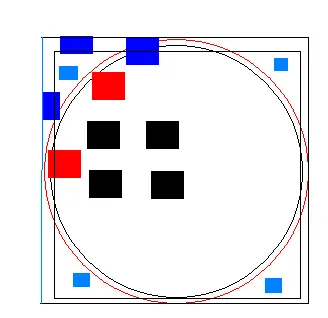我需要根据矩形与同心圆相交的情况来绘制不同填充颜色的矩形。下面的图片可以更好地说明这种情况(仅用于表示)。
伪代码如下:
即使当前逻辑可行,每个点都需要执行这些检查(4或8次),最终再将它们结合起来确定状态。在我的实际应用程序中,大约会出现3,000,000个矩形。

伪代码如下:
将这些值与内半径的平方(sqrOfInnerR)进行比较。点到中心的距离的平方(sqrOfDistance) = (点X坐标 - 圆心X坐标)的平方 + (点Y坐标 - 圆心Y坐标)的平方。
if sqrOfDistance == sqrOfInnerR
Inline
else if sqrOfDistance > sqrOfInnerR
Out
else
In
即使当前逻辑可行,每个点都需要执行这些检查(4或8次),最终再将它们结合起来确定状态。在我的实际应用程序中,大约会出现3,000,000个矩形。
private RectState CheckTheRectangleState(Rect rect, double radius, bool firstCall = true)
{
double SquareOfRadius = Square(radius);
var _x = rect.X - ControlCenter.X;
var _y = rect.Y - ControlCenter.Y;
var squareOfDistanceToTopLeftPoint = Square(_x) + Square(_y);
var squareOfDistanceToTopRight = Square(_x + rect.Width) + Square(_y);
var squareOfDistanceToBottonLeft = Square(_x) + Square(_y + rect.Height);
var squareOfDistanceToBottonRight = Square(_x + rect.Width) + Square(_y + rect.Height);
var topLeftStatus = squareOfDistanceToTopLeftPoint == SquareOfRadius ? PointStatus.Inline : (squareOfDistanceToTopLeftPoint > SquareOfRadius ? PointStatus.Out : PointStatus.In);
var topRightStatus = squareOfDistanceToTopRight == SquareOfRadius ? PointStatus.Inline : (squareOfDistanceToTopRight > SquareOfRadius ? PointStatus.Out : PointStatus.In);
var bottonLeftStatus = squareOfDistanceToBottonLeft == SquareOfRadius ? PointStatus.Inline : (squareOfDistanceToBottonLeft > SquareOfRadius ? PointStatus.Out : PointStatus.In);
var bottonRightStatus = squareOfDistanceToBottonRight == SquareOfRadius ? PointStatus.Inline : (squareOfDistanceToBottonRight > SquareOfRadius ? PointStatus.Out : PointStatus.In);
if ((topLeftStatus == PointStatus.In || topLeftStatus == PointStatus.Inline) &&
(topRightStatus == PointStatus.In || topRightStatus == PointStatus.Inline) &&
(bottonLeftStatus == PointStatus.In || bottonLeftStatus == PointStatus.Inline) &&
(bottonRightStatus == PointStatus.In || bottonRightStatus == PointStatus.Inline))
{
return firstCall ? RectState.In : RectState.Partial;
}
else
{
if (firstCall)
CheckTheRectangleState(rect, outCircleRadius, false);
}
return RectState.Out;
}
}
其中Square()是一个自定义函数,用于获取平方。Square(x){ return x*x;}
PointStatus和RectState是枚举类型,用于确定点的状态。